
Chief Architect, @Globant. Director, R7K Research & Conveyance. Author of Working Effectively with Legacy Code.
3 subscribers
How to get URL link on X (Twitter) App

https://twitter.com/rajkatie/status/1353961778691133441The idea behind this one is that you learn a lot about the quality of a design by trying to test it, but it happens at (at least) two levels. 2/


 Cantilevers were a motif. Even the stone in the walls and the furniture (which he designed) were cantilevered.
Cantilevers were a motif. Even the stone in the walls and the furniture (which he designed) were cantilevered. 
